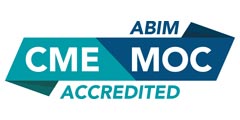
CME: Alagille syndrome: best practices in its recognition and a review of present and novel approaches to management
Activity Description / Statement of Need:
In this online, self-learning activity:
Alagille syndrome (ALGS) is a rare, autosomal dominant Notch-signaling-dysfunction genetic disorder, first described in 1969 by Daniel Alagille. Its estimated prevalence is approximately 1 in 30,000, and it is caused by mutations in one of two genes, JAG1 or NOTCH2, which play a crucial role in the development and function of several organs. Most children diagnosed with ALGS will need a liver transplant before reaching adulthood, with a transplant-free survival rate of 24 - 41% by adulthood. The condition is characterized by hepatic, cardiac, vascular, skeletal, renal, and ocular abnormalities, along with distinct facial features. There is also a substantial economic burden associated with the condition, driven primarily by frequent outpatient and costly inpatient visits. And rare diseases like ALGS can pose psychological and physical challenges for patients and families, often with inadequate support and resources.
Target Audience:
HCPs including but not limited to: pediatricians, family physicians, pediatric and adult gastroenterologists, and hepatologists; primary care practitioners, nurse practitioners, physician assistants, and pharmacists who practice in the aforementioned areas of specialty; and those who otherwise commonly care for or clinically encounter patients with ALGS.
Commercial Support Disclosure: This program is supported by an educational grant from Ipsen.
This activity is free of charge.
Release Date: December 26, 2024 -- Expiration Date: December 26, 2026
Faculty: William Balistreri, MD
Agenda
|
Faculty introduction, disclosures |
|
Review of ALGS
|
|
Medical management of ALGS
|
|
Summary, conclusion, and best practice gap |
Learning Objectives
By the end of the session the participant will be able to:
- Define Alagille syndrome (ALGS), including clinical features and genetic basis, and apply that information to a patient case.
- Summarize the clinical burden of patients with ALGS and challenges to optimal management, and apply that information to a patient case.
- Review potential therapies for ALGS and their roles in the treatment paradigm.
- Develop a treatment plan for a patient with ALGS.
Accreditation
ACCME Activity #202888574
ScientiaCME is accredited by the Accreditation Council for Continuing Medical Education (ACCME) to provide continuing medical education for physicians.
Credit Designation: ScientiaCME designates this educational activity for a maximum of 1.0 AMA PRA Category 1 Credit(s)™ toward the AMA Physician's Recognition Award. Physicians should only claim credit commensurate with the extent of their participation in the activity.

ABIM MOC Recognition Statement: Successful completion of this CME activity, which includes participation in the evaluation component, enables the participant to earn up to 1.0 MOC points in the American Board of Internal Medicine's (ABIM) Maintenance of Certification (MOC) program. It is the CME activity provider's responsibility to submit participant completion information to ACCME for the purpose of granting ABIM MOC credit.
ABIM MOC Credit Type: Medical Knowledge
ABP MOC Recognition Statement: Successful completion of this CME activity, which includes participation in the evaluation component, enables the participant to earn up to 1.0 MOC points in the American Board of Pediatrics' (ABP) Maintenance of Certification (MOC) program. It is the CME activity provider's responsibility to submit participant completion information to ACCME for the purpose of granting ABP MOC credit.
ABP MOC Credit Type: Lifelong Learning and Self-Assessment
Physicians: For maintenance of certification (MOC) points, you must enter your board certification ID # and birth date correctly. It is the learner's responsibility to provide this information completely and accurately at the completion of the activity. Without providing it, the learner will NOT receive MOC points for this activity. By providing this data, you acknowledge that it will be shared with ACCME and the applicable certifying board. Please note: Not all activities on this site provide MOC points. If this activity does not specify that it provides MOC points in this section, then it does NOT provide MOC points. This activity provides MOC points only for ABIM and ABP.
Pharmacists
ScientiaCME is accredited by the Accreditation Council for Pharmacy Education (ACPE) as a provider of continuing pharmacy education. This activity is approved for 1.0 contact hours of continuing pharmacy education credit. Proof of participation will be posted to your NABP CPE profile within 4 to 6 weeks to participants who have successfully completed the post-test. Participants must participate in the entire presentation and complete the course evaluation to receive continuing pharmacy education credit. ACPE #0574-0000-24-035-H01-P. This is an Application (A)-type activity.

Pharmacists: You must enter your NABP # and birth date correctly so that proof of participation can be posted to your NABP CPE profile. It is the learner's responsibility to provide this information completely and accurately at the completion of the activity. Without providing it, the learner will NOT receive CPE credit for this activity.
Nurses: The American Nurses Credentialing Center (ANCC) accepts AMA PRA Category 1 Credit(s)™ from organizations accredited by the ACCME. This activity is designated for up to 1.0 AMA PRA Category 1 Credit(s)™.
Physician Assistants: The American Academy of Physician Assistants (AAPA) accepts AMA PRA Category 1 Credit™ assigned by organizations accredited by the ACCME as satisfying Category 1 CME for National Commission on Certification of Physician Assistants (NCCPA) national certification maintenance. This activity is designated for up to 1.0 AMA PRA Category 1 Credit(s)™.
Nurse Practitioners: The American Academy of Nurse Practitioners Certification Board (AANPCB) states that continuing education providers accredited by the ACCME may provide acceptable, accredited Advanced Practice Provider content. This activity is designated for up to 1.0 AMA PRA Category 1 Credit(s)™.
Faculty Disclosure and Resolution of COI
As a provider of continuing medical education, it is the policy of ScientiaCME to ensure balance, independence, objectivity, and scientific rigor in all of its educational activities. In accordance with this policy, faculty and educational planners must disclose any significant relationships with commercial interests whose products or devices may be mentioned in faculty presentations, and any relationships with the commercial supporter of the activity. The intent of this disclosure is to provide the intended audience with information on which they can make their own judgments. Additionally, in the event a conflict of interest (COI) does exist, it is the policy of ScientiaCME to ensure that the COI is resolved in order to ensure the integrity of the CME activity. For this CME activity, any COI has been resolved thru content review by ScientiaCME.
Disclosures of Faculty: William F. Balistreri, MD, Professor, UC Department of Pediatrics, Cincinnati Children’s, has received financial compensation from Mirum for speaker's bureau work.
Disclosures of Educational Planners: Charles Turck, PharmD, BCPS, BCCCP, President of ScientiaCME, has no relevant financial disclosures.
Faculty WILL NOT discuss off-label uses of a commercial product.
All relevant financial relationships have been mitigated.
ScientiaCME adheres to the ACCME’s Standards for Integrity and Independence in Accredited Continuing Education. Any individuals in a position to control the content of a CE activity, including faculty, planners, reviewers or others are required to disclose all relevant financial relationships with ineligible entities (commercial interests). All relevant conflicts of interest have been mitigated prior to the commencement of the activity.
Commercial Support Disclosure: This program is supported by an educational grant from Ipsen.
Instructions
- Read the learning objectives above
- Take the Pre-Test (optional). Completion of the pre-test will help us evaluate the knowledge gained by participating in this CME activity.
- View the online activity. You may view this is in more than one session, and may pause or repeat any portion of the presentation if you need to.
- Minimum participation threshold: Take the post-test. A score of 70% or higher is required to pass and proceed to the activity evaluation.
- Complete the activity evaluation and CME registration. A CE certificate will be emailed to you immediately.
System Requirements
Windows 7 or above
Internet Explorer 8
*Adobe Acrobat Reader
Mac OS 10.2.8
Safari or Chrome or Firefox
*Adobe Acrobat Reader
Internet Explorer is not supported on the Macintosh
*Required to view Printable PDF Version
Please take a few minutes to participate in the optional pre-test. It will help us measure the knowledge gained by participating in this activity.
Additional Courses That Are Related To This Activity
Cholangiopathy management updates with an eye on the horizon: focus on primary biliary cholangitis
On the road to eliminating pneumococcal diseases: a focus on vaccination practice in adults